Wood Petrifaction: A New View of Permineralization and Replacement
Abstract
:1. Introduction
2. Historical Background
3. Organic Templating as First Step in Permineralization
4. SEM Evidence
5. Effect of Hydrofluoric Acid Treatment
6. Analyses of Relict Organic Matter
7. Examples of Permineralization
7.1. Calcareous Mineralizaton, Including Coal Balls
7.2. Siliceous Lagerstätten
7.3. Modern Hot Springs
7.4. Laboratory Simulations
8. Discussion
Acknowledgments
Conflicts of Interest
Appendix A. Analytical Methods
References
- Mustoe, G.E.; Acosta, M. Origin of petrified wood color. Geosciences 2016, 6, 25. [Google Scholar] [CrossRef]
- St. John, R.N. Replacement vs. impregnation in petrified wood. Econ. Geol. 1927, 22, 729–739. [Google Scholar] [CrossRef]
- Stewart, W.N.; Rothwell, G.W. Paleontology and the Evolution of Plants, 2nd ed.; Cambridge University Press: Cambridge, UK, 1993; p. 9. [Google Scholar]
- Arnold, C.A. Introduction to Paleobotany; McGraw-Hill: New York, NY, USA, 1947; p. 35. [Google Scholar]
- Andrews, H.N., Jr. Studies in Palaeobotany; John Wiley & Sons: New York, NY, USA, 1961; p. 14. [Google Scholar]
- Leo, R.F.; Barghoorn, E.S. Silicification of wood. Harv. Univ. Bot. Mus. Leafl. 1976, 25, 1–47. [Google Scholar]
- Mustoe, G.E. Mineralogy and geochemistry of late Eocene silicified wood from Florissant Fossil Beds National Monument, Colorado. In Paleontology of the Upper Eocene Florissant Formation, Colorado; Meyer, H.W., Smith, D.M., Eds.; Geological Society of America: Boulder, CO, USA, 2008; Volume 435, pp. 127–140. [Google Scholar]
- Mustoe, G.E. Late Tertiary petrified wood from Nevada, USA: Evidence of multiple silicification pathways. Geosciences 2015, 5, 286–309. [Google Scholar] [CrossRef]
- Viney, M.; Dietrich, D.; Mustoe, G.; Link, P.; Lampke, T.; Gőtze, J.; Rőßler, R. Multi-stage silicification of Pliocene wood: Re-examination on an 1895 discovery from Idaho, USA. Geoscience 2016, 6, 21. [Google Scholar] [CrossRef]
- Mustoe, G.E. Density and loss on ignition as indicators of the fossilization of silicified wood. IAWA J. 2016, 37, 98–111. [Google Scholar] [CrossRef]
- Hooker, J.D.; Binney, E.W. On the structure of certain limestone nodules enclosed in seams of bituminous coal, with a description of some trigonocarpons contained in them. Philos. Trans. R. Soc. 1855, 145, 149–156. [Google Scholar] [CrossRef]
- Scott, A.C.; Rex, G.M. The formation and significance of Carboniferous coal balls. Philos. Trans. R. Soc. Lond. B Biol. Sci. 1985, 311, 123–137. [Google Scholar] [CrossRef]
- Atkinson, B.; Rothwell, G.; Stockey, R.A. Hubbardiastrobus cunninghamiodes gen. et sp. nov, evolution of a lower Cretaceous diversification of Cunninghamioid Cupressaceae. Int. J. Plant Sci. 2015, 175, 256–259. [Google Scholar] [CrossRef]
- Bomfleur, B.; McLoughlin, S.; Vajda, V. Fossilized nuclei and chromosomes reveal 180 million years of genomic stasis in royal ferns. Science 2014, 343, 1376–1377. [Google Scholar] [CrossRef] [PubMed]
- Rice, C.M.; Ashcroft, W.A.; Batten, D.J.; Boyce, A.J.; Caufield, J.B.D.; Fallick, A.E. A Devonian auriferous hot spring, Rhynie, Scotland. J. Geol. Soc. Lond. 1995, 159, 229–250. [Google Scholar] [CrossRef]
- Rice, C.M.; Trewin, N.H.; Anderson, L.I. Geological setting of the Early Devonian Rhynie cherts, Aberdeenshire, Scotland: An early terrestrial hot spring system. J. Geol. Soc. Lond. 2002, 159, 203–214. [Google Scholar] [CrossRef]
- Trewin, N.H.; Fayers, S.R.; Kelman, R. Subaqueous silicification of the contents of small ponds in and Early Devonian hot-spring complex, Rhynie, Scotland. Can. J. Earth Sci. 1967, 40, 1697–1712. [Google Scholar] [CrossRef]
- Mustoe, G.E. Cyclic sedimentation in the Eocene Allenby Formation of south-central British Columbia and the origin of the Princeton Chert fossil beds. Can. J. Earth Sci. 2011, 48, 25–43. [Google Scholar] [CrossRef]
- Kidston, R.; Lang, W.H. On Old Red Sandstone plants showing structure, from the Rhynie chert bed, Aberdeenshire. Part I. Rhynia gwynne-vaughani Kidston & Lang. Trans. R. Soc. Edinb. 1917, 51, 761–784. [Google Scholar]
- Edwards, D.S. Evidence for the sporophytic status of the Lower Devonian plant Rhynia Gwynne-vaughanii Kidston and Lang. Rev. Palaeobot. Palynol. 1980, 29, 177–188. [Google Scholar] [CrossRef]
- Sagasti, A.J.; Massini, J.G.; Escapa, I.H.; Guido, D.M.; Channing, A. Millerocaulis zamunerae sp. nov. (Osmundaceae) from Jurassic, geothermally influenced, wetland environments of Patagonia, Argentine. Alcheringa Aust. J. Paleontol. 2016, 40, 451–474. [Google Scholar]
- White, D.E.; Hutchinson, R.A.; Keith, T.E.C. The Geology and Remarkable Thermal Activity of Norris Geyser Basin, Yellowstone National Park, Wyoming; U.S. Geological Survey Professional Paper: Reston, VA, USA, 1988; p. 84. [Google Scholar]
- Hellawell, J.; Ballhaus, C.; Gee, C.T.; Mustoe, G.E.; Nagel, T.J.; Wirth, R.; Rethemeyer, J.; Tomaschek, F.; Geisler, T.; Greef, K.; et al. Incipient silicification of recent conifer wood at a Yellowstone hot spring. Geochim. Cosmochim. Acta 2015, 149, 79–87. [Google Scholar] [CrossRef]
- Allen, E.T.; Day, A.L. Hot Springs of the Yellowstone National Park; Carnegie Institution of Washington Publication: Washington, DC, USA, 1935; pp. 161–163. [Google Scholar]
- Akahane, H.; Furuno, T. Recent silicified woods in the Tatyama Hot Spring (Shin-yu), Toyama Prefecture. J. Geol. Soc. Jpn. 1993, 99, 457–466. [Google Scholar] [CrossRef]
- Akahane, H.; Furuno, T.; Miyama, H.; Yoshikawa, T.; Yamamoto, S. Rapid wood silicification in hot spring water: An explanation of silicification of wood during the Earth’s history. Sediment. Geol. 2004, 169, 219–228. [Google Scholar] [CrossRef]
- Channing, A.; Edwards, D. Experimental taphonomy: Silicification of plants in Yellowstone hot-spring environments. Trans. R. Soc. Edinb. 2003, 94, 503–521. [Google Scholar] [CrossRef]
- Dietrich, D.; Viney, M.; Lampke, T. Petrifactions and wood-templated ceramics: Comparisons between natural and artificial silicifications. IAWA J. 2015, 36, 167–185. [Google Scholar] [CrossRef]
- Goëtze, J.; Möckel, R.; Langhof, N.; Hengst, M.; Klinger, M. Silicification of wood in the laboratory. Silik. Ceram. 2008, 52, 268–277. [Google Scholar]
- Shin, Y.; Jun, L.; Jeong, H.C.; Zimin, N.; Exharos, G.J. Hierarchically ordered ceramics through surfactant-templated sol-gel mineralization of biological cellular structures. Adv. Mater. 2001, 13, 728–732. [Google Scholar] [CrossRef]
- Shin, Y.; Wang, C.; Exharos, G.J. Synthesis of SiC ceramics by carbothermal reduction of mineralized wood with silica. Adv. Mater. 2005, 17, 71–73. [Google Scholar] [CrossRef]
- Dong, A.; Yajun, W.; Yi, T.; Nan, R.; Yahong, Z.; Yinhong, Y.; Zi, G. Zeolitic tissue through wood cell templating. Adv. Mater. 2002, 14, 926–929. [Google Scholar] [CrossRef]
- Ballhaus, C.; Gee, C.T.; Bockrath, C.; Greef, K.; Mansfeldt, T.; Rhede, D. The silicification of trees in volcanic ash—An experimental study. Geochim. Cosmochim. Acta 2012, 84, 62074. [Google Scholar] [CrossRef]
- Mustoe, G.E.; Viney, M. Mineralogy of Paleocene petrified wood from Cherokee Ranch Fossil Forest, central Colorado, USA. Geosciences 2017, 7, 23. [Google Scholar] [CrossRef]
- Saminpanya, S.; Sutherland, F.L. Silica phase-transformations during diagenesis within petrified woods found in fluvial deposits from Thailand-Myanmar. Sediment. Geol. 2013, 290, 15–26. [Google Scholar] [CrossRef]
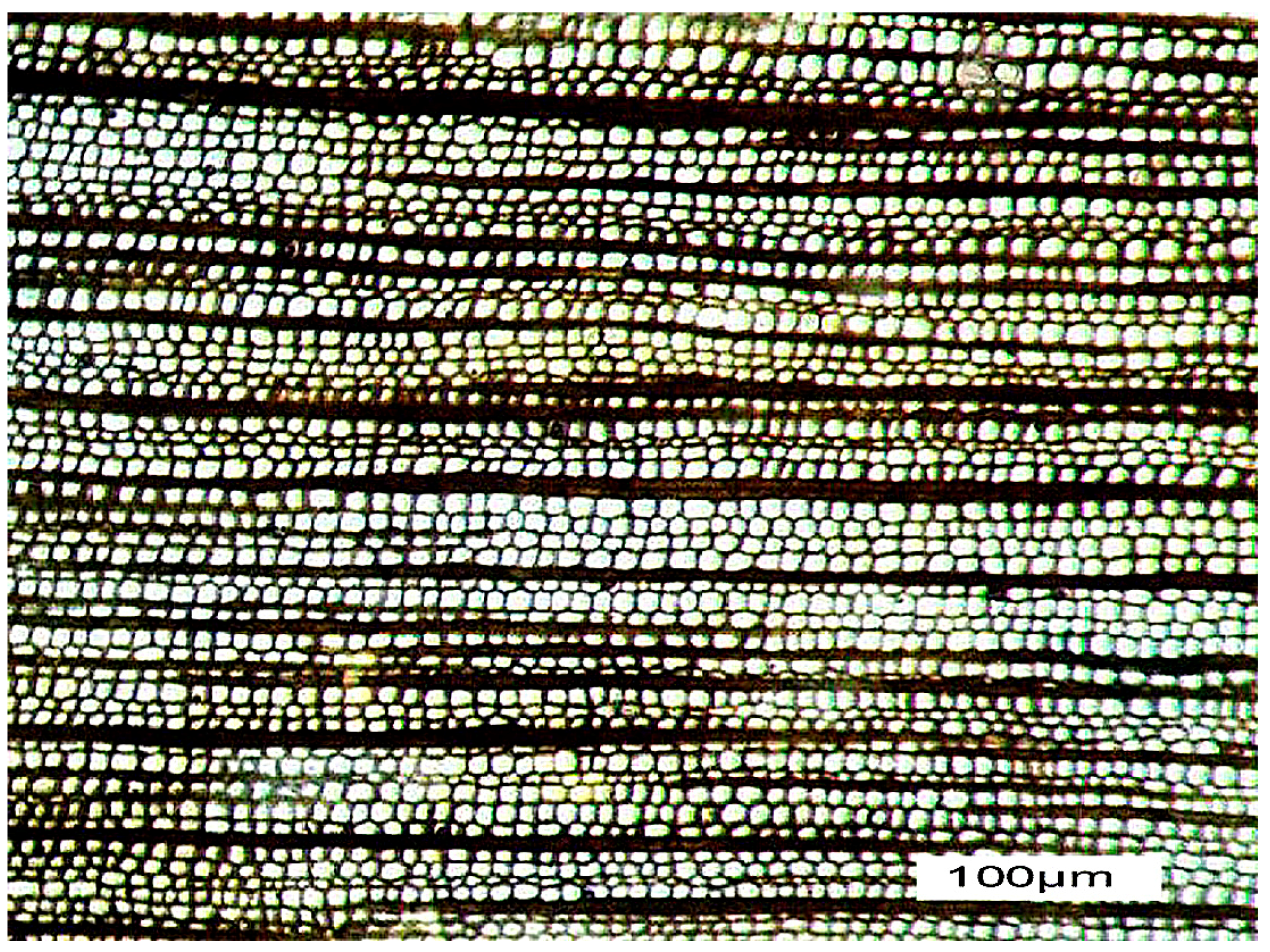
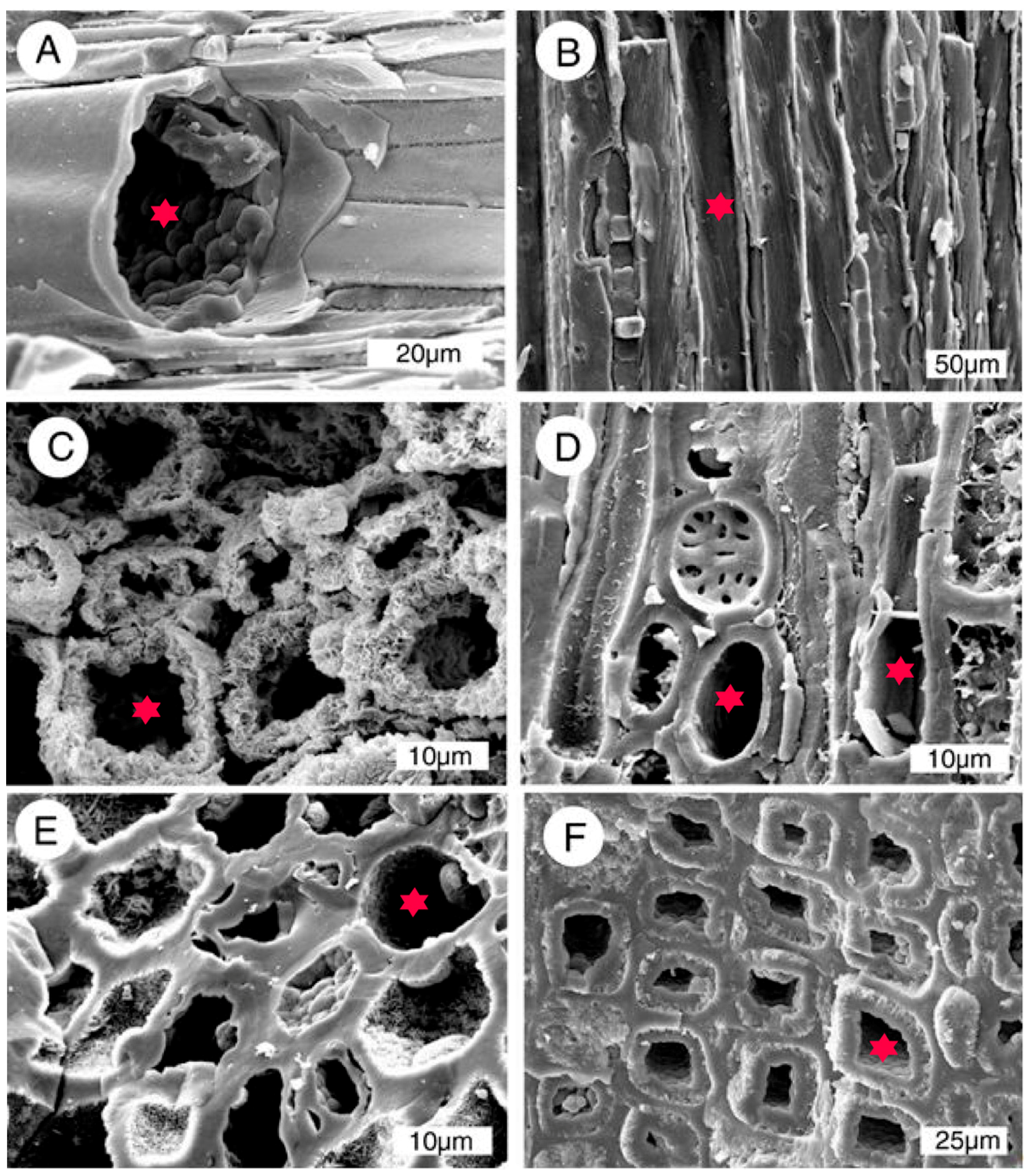

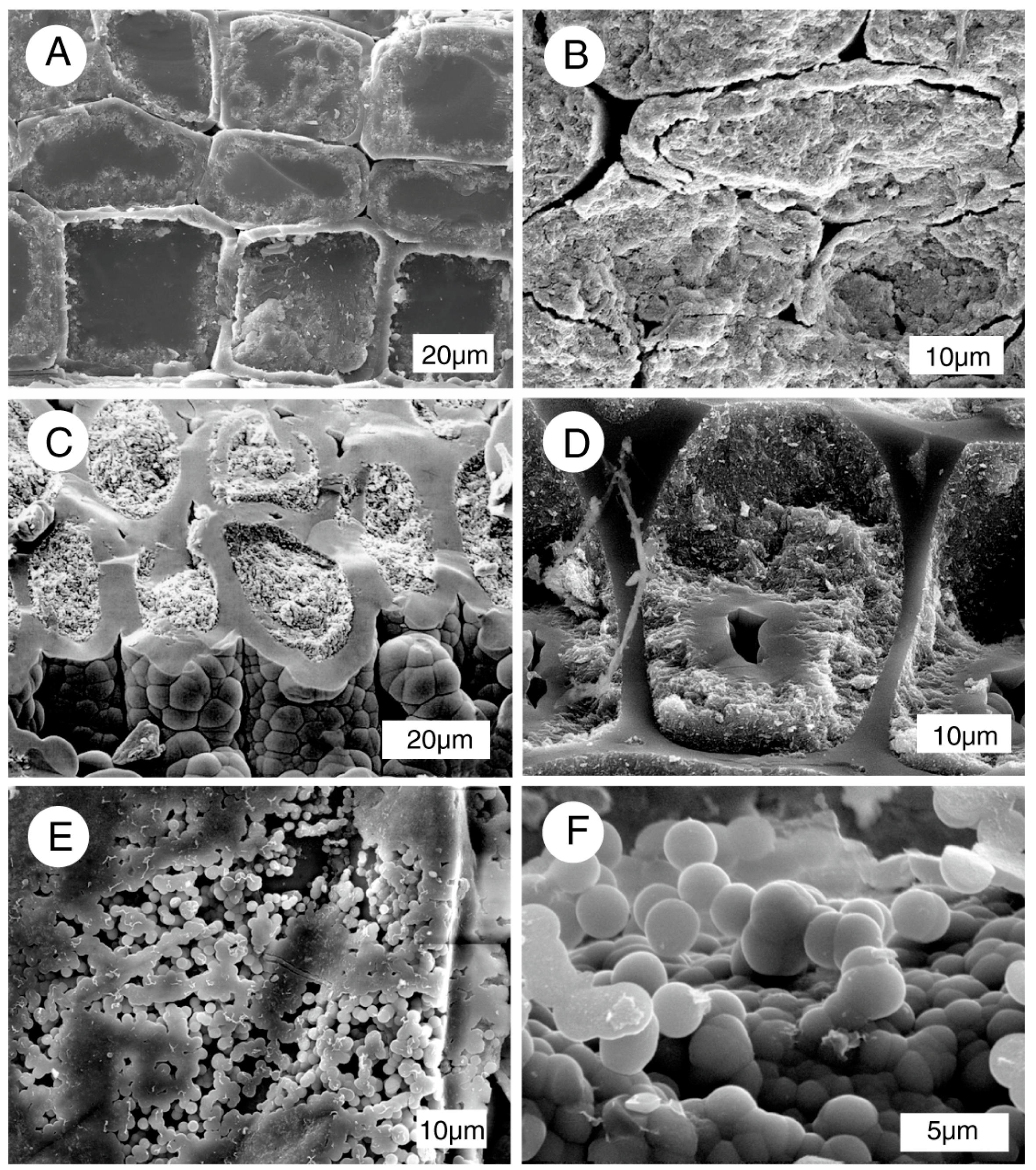
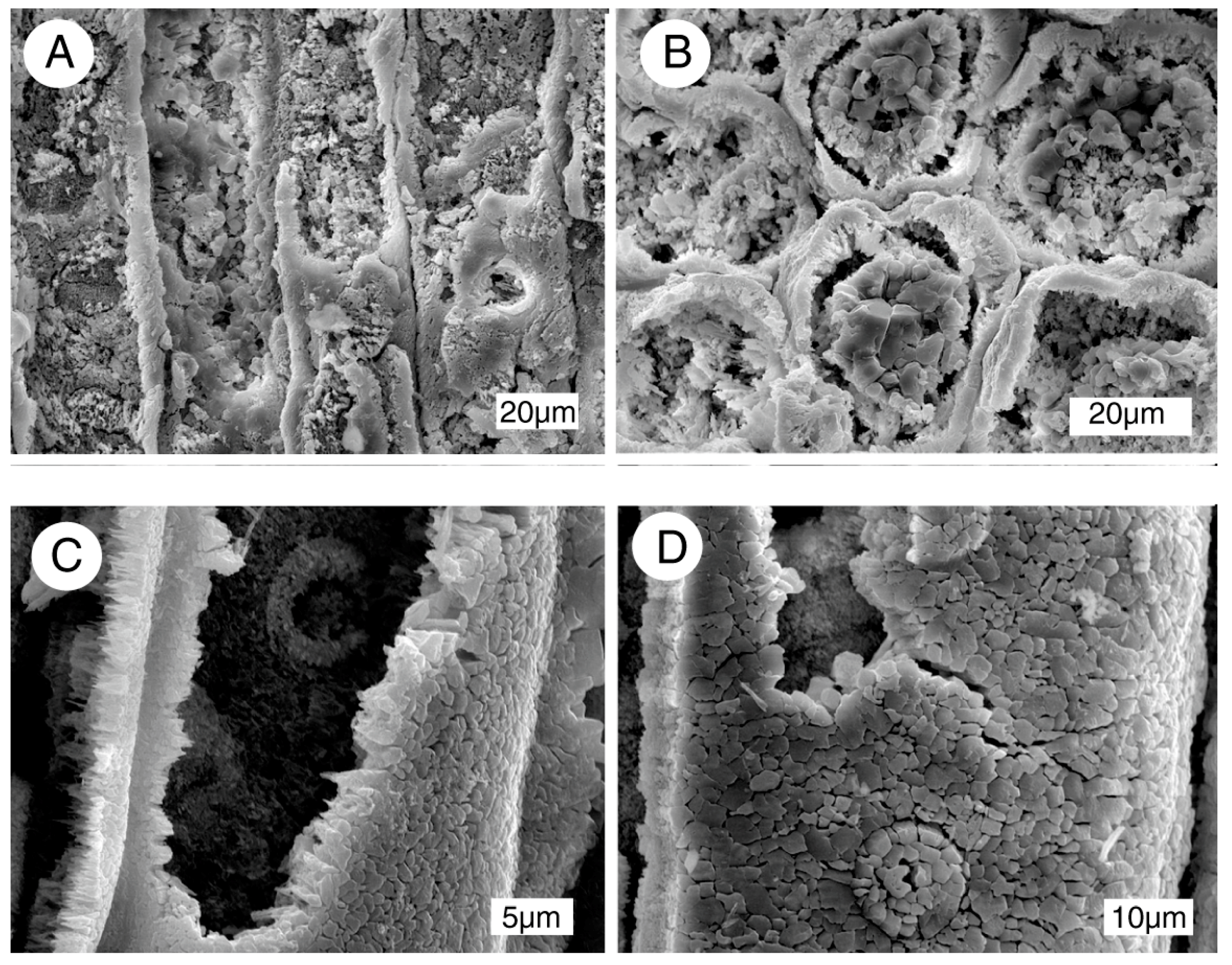
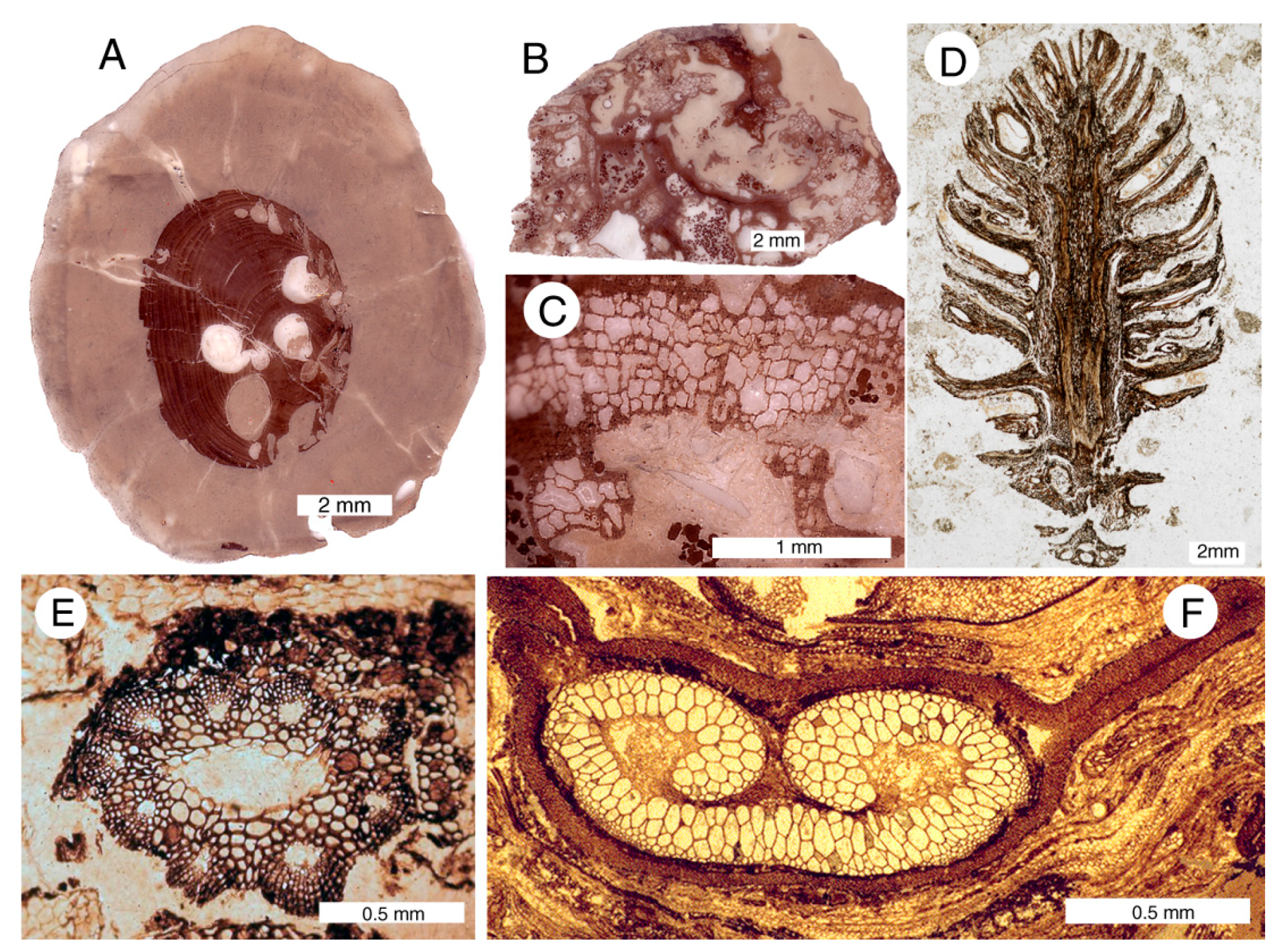


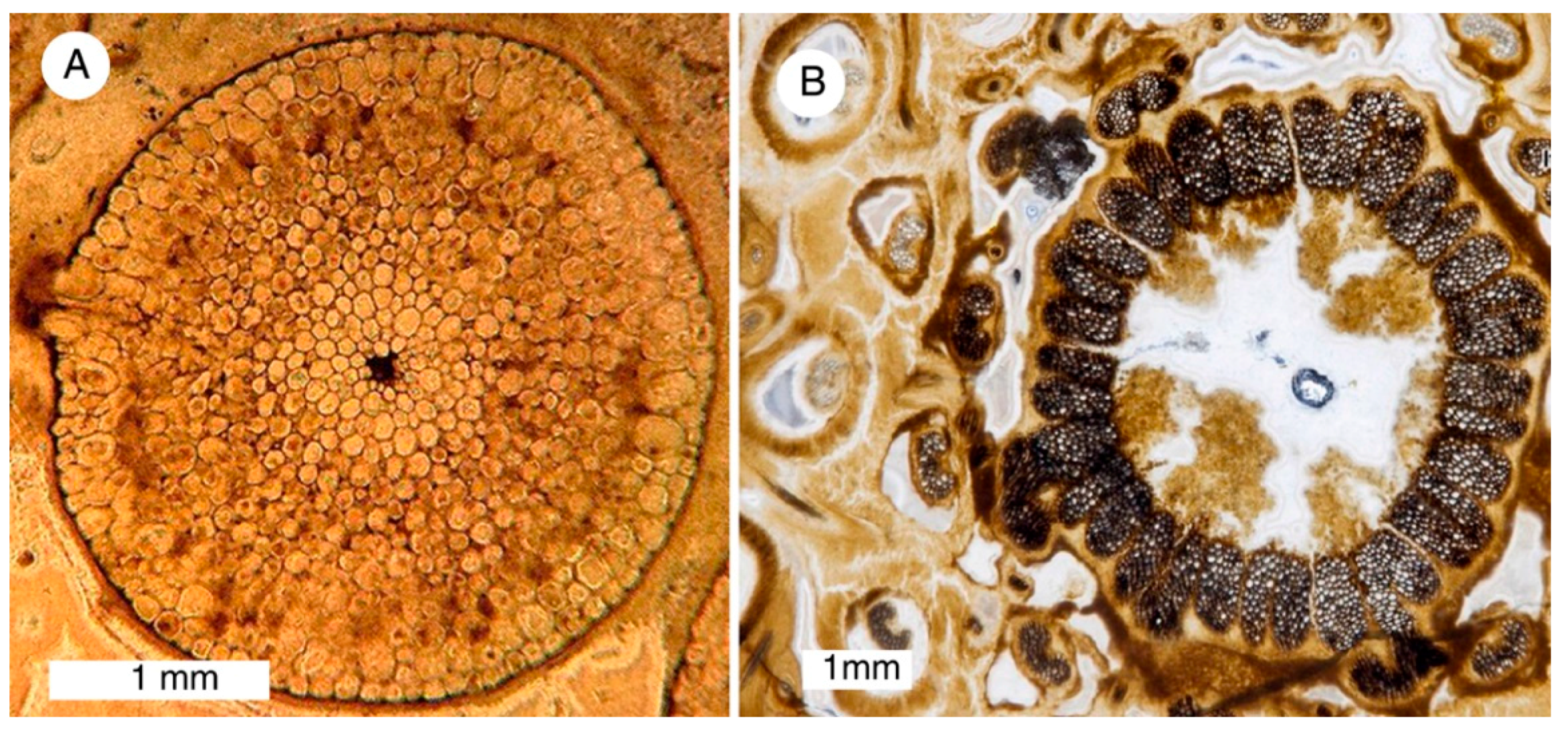

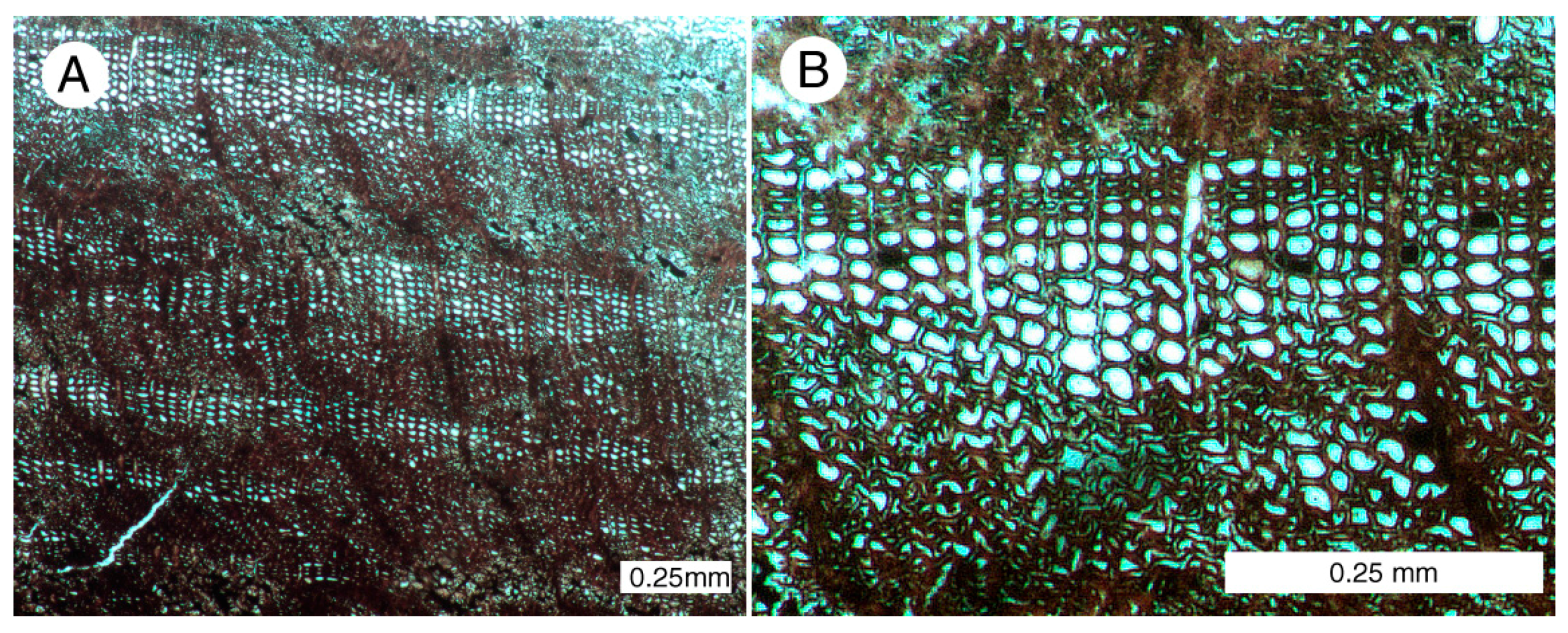
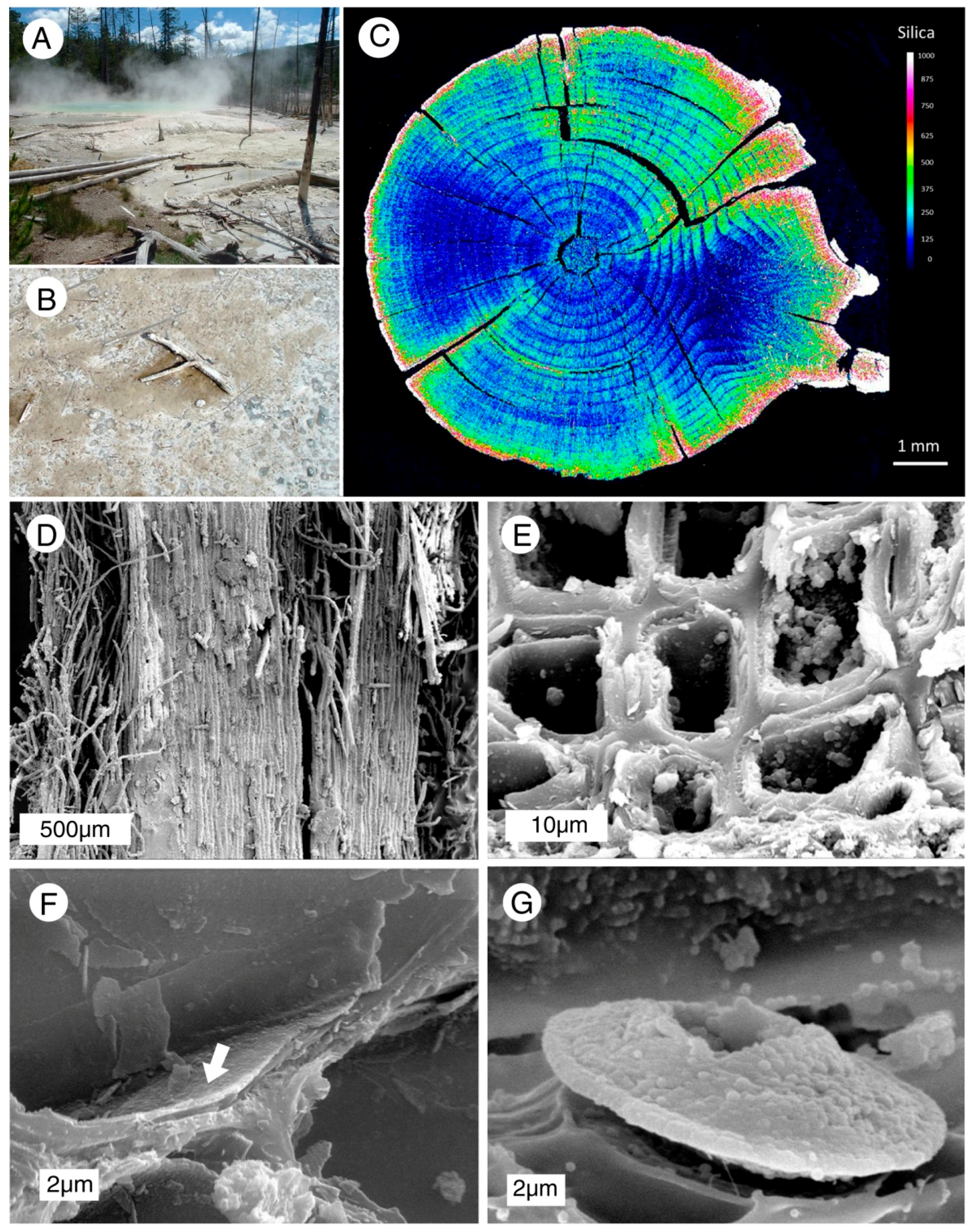
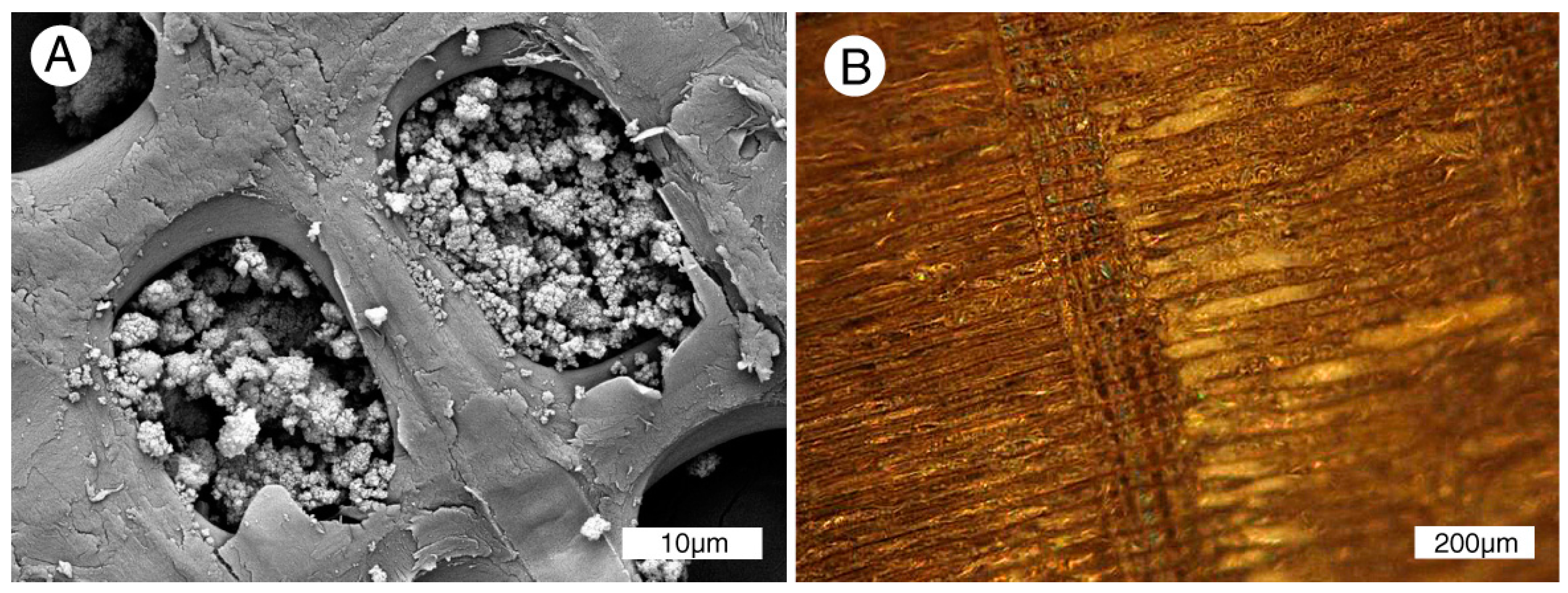
| Age | Location | Genus | Mineralogy * | Density g/cm3 | % LOI 450° ** | Estimated Original Density *** | Calculated % Original Wood |
|---|---|---|---|---|---|---|---|
| Devonian | Murray, OK | Callixylon | chalcedony | 2.49 | 0.41 | - | - |
| Triassic | Holbrook, AZ | Araucarioxylon | chalcedony | 2.62 | 0.19 | 0.52 | 0.96 |
| Cretaceous | Montague Co., TX | Cupressinoxylon | quartz | 2.53 | 0.55 | 0.45 | 3.09 |
| Eocene | Leesville, LA | Palmoxylon | chalcedony | 2.58 | 0.14 | 0.56 | 0.65 |
| Eocene | Eden Valley, WY | Palmoxylon | chalcedony | 2.50 | 1.39 | 0.56 | 6.21 |
| Eocene | Watertree River, SC | Palmoxylon | chalcedony | 2.32 | 2.20 | 0.56 | 9.11 |
| Oligocene | Panama | Palmoxylon | chalcedony | 2.57 | 1.24 | 0.56 | 5.69 |
| Paleocene | North Dakota | Metasequoia | chalcedony | 2.60 | 0.33 | 0.45 | 1.91 |
| Oligocene | Rapid City, SD | Metasequoia | chalcedony | 2.62 | 0.27 | 0.45 | 1.57 |
| Eocene | Florissant, CO | Sequoioxylon | chalcedony | 2.53 | 0.36 | 0.45 | 2.02 |
| Eocene | Florissant, CO | Sequoioxylon | chalcedony | 2.41 | 0.43 | 0.45 | 2.30 |
| Eocene | Gallatin Co., MT | Sequoioxylon | quartz | 2.48 | 3.94 | 0.45 | 21.71 |
| Miocene | Yakima, WA | Platanus | chalcedony | 2.37 | 0.83 | 0.56 | 3.51 |
| Miocene | Yakima, WA | Ulmus | opal-CT | 1.95 | 2.18 | 0.60 | 7.09 |
| Miocene | Madras, OR | Quercinium | opal-CT | 2.01 | 2.80 | 0.74 | 7.61 |
| Miocene | Swartz Canyon, OR | Quercinium | chalcedony | 2.58 | 0.78 | 0.74 | 2.72 |
| Miocene | Bliss Co., Idaho | Quercinium | opal-CT | 1.93 | 1.65 | 0.74 | 4.30 |
| Pleistocene | Florida | Taxodium | chalcedony | 2.54 | 0.55 | 0.48 | 2.91 |
| Eocene | Cache Creek, BC | unknown | opal-CT | 2.07 | 4.49 | 0.45 | 20.65 |
| Miocene | Miller Mtn., NV | unknown | opal-CT | 2.07 | 3.75 | 0.45 | 17.25 |
| Miocene | Yakima Co., WA | Cupressinoxylon | opal-CT | 1.99 | 3.28 | 0.45 | 14.50 |
| Miocene | Washoe County, NV | unknown | opal-CT | 1.86 | 2.77 | 0.45 | 11.45 |
| Miocene | Rawhide, NV | unknown | opal-CT | 1.85 | 4.68 | 0.45 | 19.24 |
| Miocene | Lake Tahoe, CA | unknown | opal-CT | 1.90 | 3.25 | 0.45 | 13.72 |
| Neogene | Columbia | unknown | opal-CT | 1.90 | 2.66 | 0.45 | 11.23 |
| Miocene | Nye County, NV | conifer | opal-CT | 1.90 | 1.61 | 0.45 | 6.80 |
© 2017 by the author. Licensee MDPI, Basel, Switzerland. This article is an open access article distributed under the terms and conditions of the Creative Commons Attribution (CC BY) license (http://creativecommons.org/licenses/by/4.0/).
Share and Cite
Mustoe, G.E. Wood Petrifaction: A New View of Permineralization and Replacement. Geosciences 2017, 7, 119. https://doi.org/10.3390/geosciences7040119
Mustoe GE. Wood Petrifaction: A New View of Permineralization and Replacement. Geosciences. 2017; 7(4):119. https://doi.org/10.3390/geosciences7040119
Chicago/Turabian StyleMustoe, George E. 2017. "Wood Petrifaction: A New View of Permineralization and Replacement" Geosciences 7, no. 4: 119. https://doi.org/10.3390/geosciences7040119





